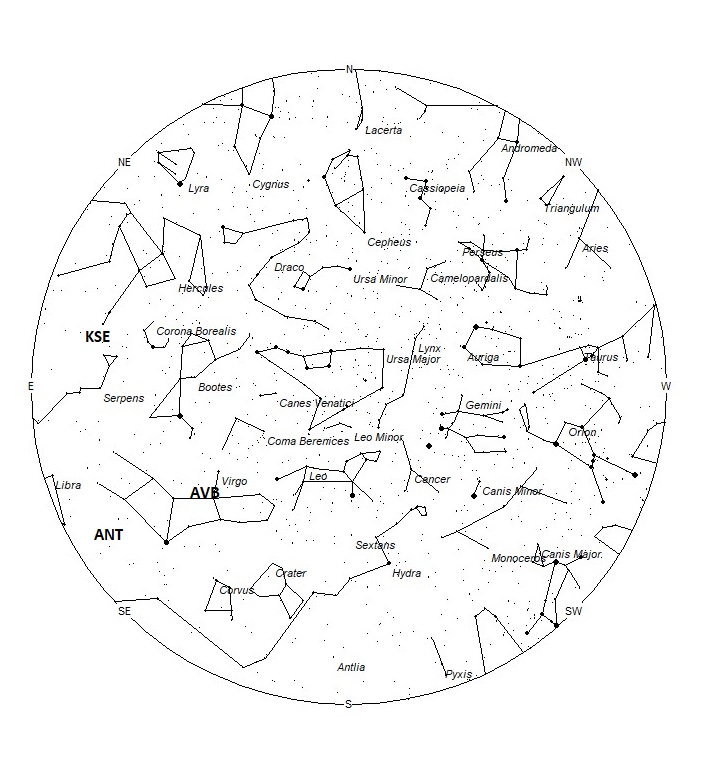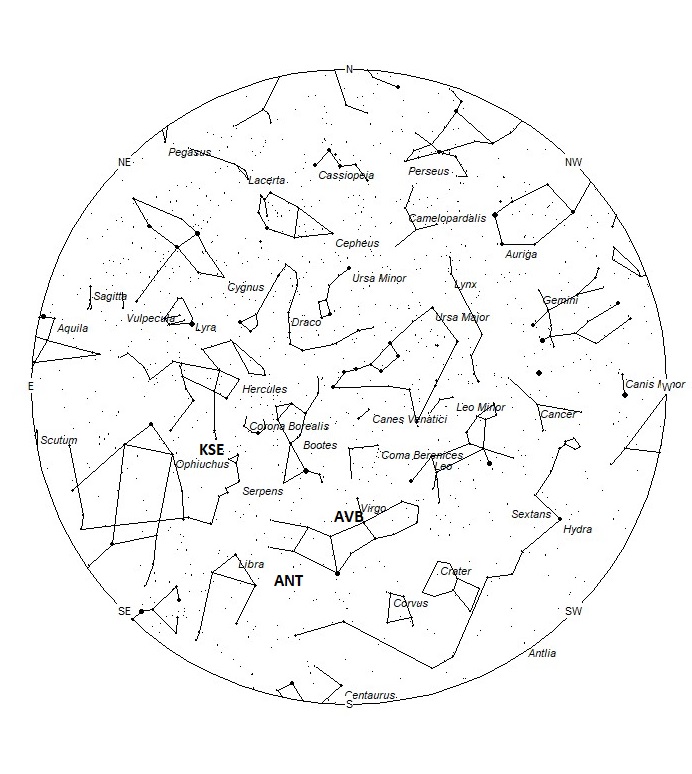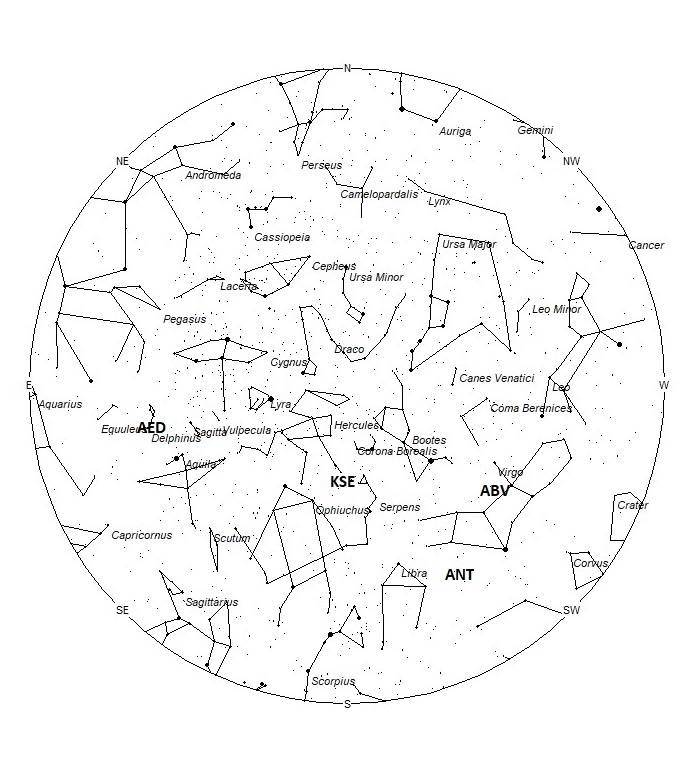During this period, the moon reaches its first quarter phase on Saturday April 9th. The half-illuminated moon will interfere with evening and early morning meteor observations as it doesn’t set until 03:00-04:00, allowing only a small remainder of the night to be free of interfering moonlight. As the week progresses, the moon sets later and later, interfering all night long by the end of the period. For evening observers, the estimated total hourly rates should be near 2 as seen from mid-northern latitudes (45N) and 3 as seen from tropical southern locations (25S) For morning observers, the estimated total hourly rates should be near 7 as seen from mid-northern latitudes (45N) and 13 as seen from tropical southern locations (25S). The actual rates will also depend on factors such as personal light and motion perception, local weather conditions, alertness, and experience in watching meteor activity. Evening rates are reduced during this period due to moonlight. Note that the hourly rates listed below are estimates as viewed from dark sky sites away from urban light sources. Observers viewing from urban areas will see less activity as only the brighter meteors will be visible from such locations.
The radiant (the area of the sky where meteors appear to shoot from) positions and rates listed below are exact for Saturday night/Sunday morning April 9/10. These positions do not change greatly day to day so the listed coordinates may be used during this entire period. Most star atlases (available at science stores and planetariums) will provide maps with grid lines of the celestial coordinates so that you may find out exactly where these positions are located in the sky. I have also included charts of the sky that display the radiant positions for evening, midnight, and morning. The center of each chart is the sky directly overhead at the appropriate hour. These charts are oriented for facing south but can be used for any direction by rotating the charts to the desired direction. A planisphere or computer planetarium program is also useful in showing the sky at any time of night on any date of the year. Activity from each radiant is best seen when it is positioned highest in the sky, either due north or south along the meridian, depending on your latitude. It must be remembered that meteor activity is rarely seen at the radiant position. Rather they shoot outwards from the radiant, so it is best to center your field of view so that the radiant lies at the edge and not the center. Viewing there will allow you to easily trace the path of each meteor back to the radiant (if it is a shower member) or in another direction if it is sporadic. Meteor activity is not seen from radiants that are located far below the horizon. The positions below are listed in a west to east manner in order of right ascension (celestial longitude). The positions listed first are located further west therefore are accessible earlier in the night while those listed further down the list rise later in the night.
These sources of meteoric activity are expected to be active this week.
The alpha Virginids (AVB) were first mentioned by R. B. Southworth and G. S. Hawkins in their publication known as Smithsonian Contributions to Astrophysics (1963). These meteors are active from April 6 though May 1 with maximum occurring on April 18th. The current location of this radiant is 13:08 (197) +04. This position is located in central Virgo, 2 degrees northeast of the 3rd magnitude star known as Minelauva (delta Virginis). This radiant is best placed near 01:00 local summer time (LST) when it lies on the meridian and is highest in the sky. Rates at this time should be less than 1 per hour no matter your location. With an entry velocity of 21 km/sec., the average meteor from this source would be of very slow velocity. This source is far enough from the core of the anthelion radiant to be noticed but care must be taken to differentiate between the two radiants.
The large Anthelion (ANT) is currently centered at 14:12 (213) -13. This position lies in southeastern Virgo, 3 degrees south of the 4th magnitude star known as Kang (kappa Virginis). Due to the large size of this radiant, these meteors may also be seen from Libra as well as eastern Virgo. This radiant is best placed near 02:00 LST when it lies on the meridian and is highest in the sky. Rates at this time should be near 2 per hour as seen from the Northern Hemisphere and 3 as seen from south of the equator. With an entry velocity of 30 km/sec., the average Anthelion meteor would be of slow velocity.
The kappa Serpentids (KSE) were discovered by A.F. Cook from data provided by B. A. Lindblad, R.E. McCrosky, and A. Posen. These meteors are active from April 11-22, with maximum activity occurring on the 16th. The radiant currently lies at 16:14 (243) +17. This area of the sky actually lies in southwestern Hercules, 2 degrees southwest of the 4th magnitude star known as gamma Herculis. With an entry velocity of 47km/sec., the average meteor from this source would be of medium-fast velocity. These meteors are best seen near 04:00, when the radiant lies on the meridian and is situated highest in the sky. Hourly rates this week are expected to be less than 1.
The April epsilon Delphinids (AED) were discovered by P. Jenniskens and R. Rudawska from CAMS and SonotaCo meteoroid orbit surveys published in 2014.This weak source is active from March 31 through April 20, with maximum activity occurring on April 9th. The radiant currently lies at 20:31 (308) +12. This position lies in the central Delphinus, 1 degree northwest of the 4th magnitude star known as Aldulfin (epsilon Delphini). With an entry velocity of 61km/sec., the average meteor from this source would be of fast velocity. These meteors are best seen during the last dark hour prior to morning twilight. Hourly rates this week are expected to be less than 1.
The delta Pavonids (DPA) were discovered by Michael Buhagiar from Australia in the 1970’s. These meteors are active from March 11 through April 16, with maximum activity occurring on March 30th. The current position of the radiant lies near 21:36 (324) -65. This area of the sky lies on the Pavo/Indus border, 1 degrees northeast of the 4th magnitude star known as gamma Pavonis. These meteors are best seen during the last dark hour prior to dawn. With an entry velocity of 58km/sec., the average meteor from this source would be of fast velocity. Expected rates are less than 1 per hour during this period. These meteors are poorly seen from the Northern Hemisphere.
As seen from the mid-northern hemisphere (45N) one would expect to see approximately 5 sporadic meteors per hour during the last hour before dawn as seen from rural observing sites. Evening rates would be near 1 per hour. As seen from the tropical southern latitudes (25S), morning rates would be near 10 per hour as seen from rural observing sites and 2 per hour during the evening hours. Locations between these two extremes would see activity between the listed figures. During this period evening rates are reduced due to moonlight.
You can keep track of the activity of these meteor showers as well as those beyond the limits of visual observing by visiting the NASA Meteor Shower Portal available at: https://meteorshowers.seti.org/ You can move the sky globe to see different areas of the sky. Colored dots indicate shower meteors while white dots indicate sporadic (random) activity. The large orange disk indicates the position of the sun so little activity will be seen in that area of the sky.
| SHOWER | DATE OF MAXIMUM ACTIVITY | CELESTIAL POSITION | ENTRY VELOCITY | CULMINATION | HOURLY RATE | CLASS |
| RA (RA in Deg.) DEC | Km/Sec | Local Summer Time | North-South | |||
| alpha Virginids (AVB) | Apr 18 | 13:08 (197) +04 | 21 | 01:00 | <1 – <1 | IV |
| Anthelions (ANT) | — | 14:12 (213) -13 | 30 | 02:00 | 2 – 3 | II |
| kappa Serpentids (KSE) | Apr 16 | 16:14 (243) +17 | 47 | 04:00 | <1 – <1 | IV |
| April epsilon Delphinids (AED) | Apr 09 | 20:31 (308) +12 | 61 | 08:00 | <1 – <1 | IV |
| Delta Pavonids (DPV) | Mar 31 | 21:36 (324) -65 | 58 | 09:00 | <1 – <1 | III |




